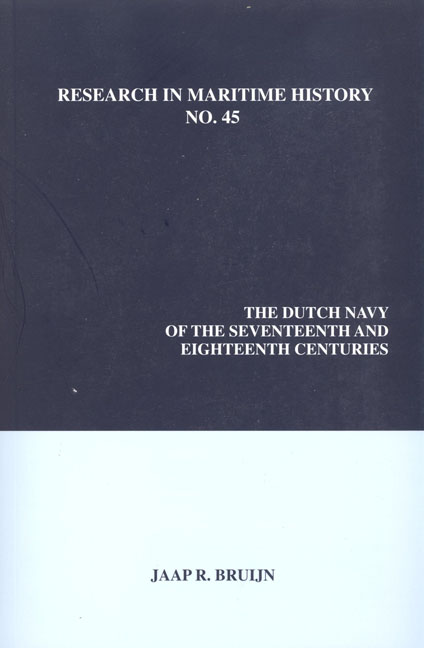Book contents
- Frontmatter
- Contents
- Illustrations
- Tables
- Series Editor's Foreword
- About the Author
- Introduction to the 2011 Edition
- Foreword
- Preface
- Introduction
- Map of the Dutch Republic
- Map of Dutch Naval Activity in European Waters
- Part One The “Old” Navy, Late 1500s-1652
- Part Two The “New” Navy, 1652-1713
- The “Old” Navy Out of Date
- John de Witt's New Navy
- An Era of Naval Campaigns against England and France and in the Baltic
- Changes in the Naval Administration
- De Ruyter and the Other Naval Officers
- Well-manned Ships
- Part Three A Second-Rate Navy, 1714-1795
- In Retrospect
- Bibliography
- Index
The “Old” Navy Out of Date
from Part Two - The “New” Navy, 1652-1713
- Frontmatter
- Contents
- Illustrations
- Tables
- Series Editor's Foreword
- About the Author
- Introduction to the 2011 Edition
- Foreword
- Preface
- Introduction
- Map of the Dutch Republic
- Map of Dutch Naval Activity in European Waters
- Part One The “Old” Navy, Late 1500s-1652
- Part Two The “New” Navy, 1652-1713
- The “Old” Navy Out of Date
- John de Witt's New Navy
- An Era of Naval Campaigns against England and France and in the Baltic
- Changes in the Naval Administration
- De Ruyter and the Other Naval Officers
- Well-manned Ships
- Part Three A Second-Rate Navy, 1714-1795
- In Retrospect
- Bibliography
- Index
Summary
The establishment of the English Commonwealth in 1649 had a great and immediate impact not only on English naval administration and fleet but, by example, on those of the Dutch as well. Within a month of the execution of Charles I, the English republican leaders began to remodel the navy. Above all, the navy had to become politically reliable, but the style of command was also to be changed. One-man leadership was abolished, and three colonels were appointed “admirals and generals of the fleet.” These new commanders were well equipped, and their title of “general at sea” was to stimulate a close liaison between the army and navy. An interchange between service afloat and ashore was even envisaged. The officer corps was reconstructed, though the old guard was not completely dropped. Naval service became more attractive. Conditions of service were improved. Officers’ salaries were increased - captains even received fifty percent raise - as part of a new, overall wage structure, set up in 1653. Each seaman's share in prize money was enlarged. Discipline on board ship was regulated by “Laws and Ordinances Martial.” Shore administration was also reorganized.
The new republican leaders of England also embarked at once on a major program of naval shipbuilding and rearmament, their first orders for new ships placed in March 1649. By the end of 1651, twenty new men-of-war had been built and a further twenty-five added by purchase or capture, almost doubling the size of the British fleet. The names of several older ships were even changed on ideological grounds: Royal Sovereign, the largest ship, was renamed Commonwealth but later came to be known as Sovereign. The great majority of ships built were men-of-war, by tradition more heavily constructed than their Dutch counterparts. And the new naval leaders discovered that most of the ships could carry far more guns than was specified in the original design. An increase of forty-two to fifty-six or sixty guns was quite common. On the eve of the first confrontation between the English and the Dutch, the navy of the Commonwealth had at its disposal a complement of about eighty-six ships. The armament of no less than fourteen ships was equal to, or far greater than, the number of guns aboard the Dutch flagship Brederode. And even smaller English ships were considered to have greater fighting power than Tromp's own flagship.
- Type
- Chapter
- Information
- Publisher: Liverpool University PressPrint publication year: 2011

